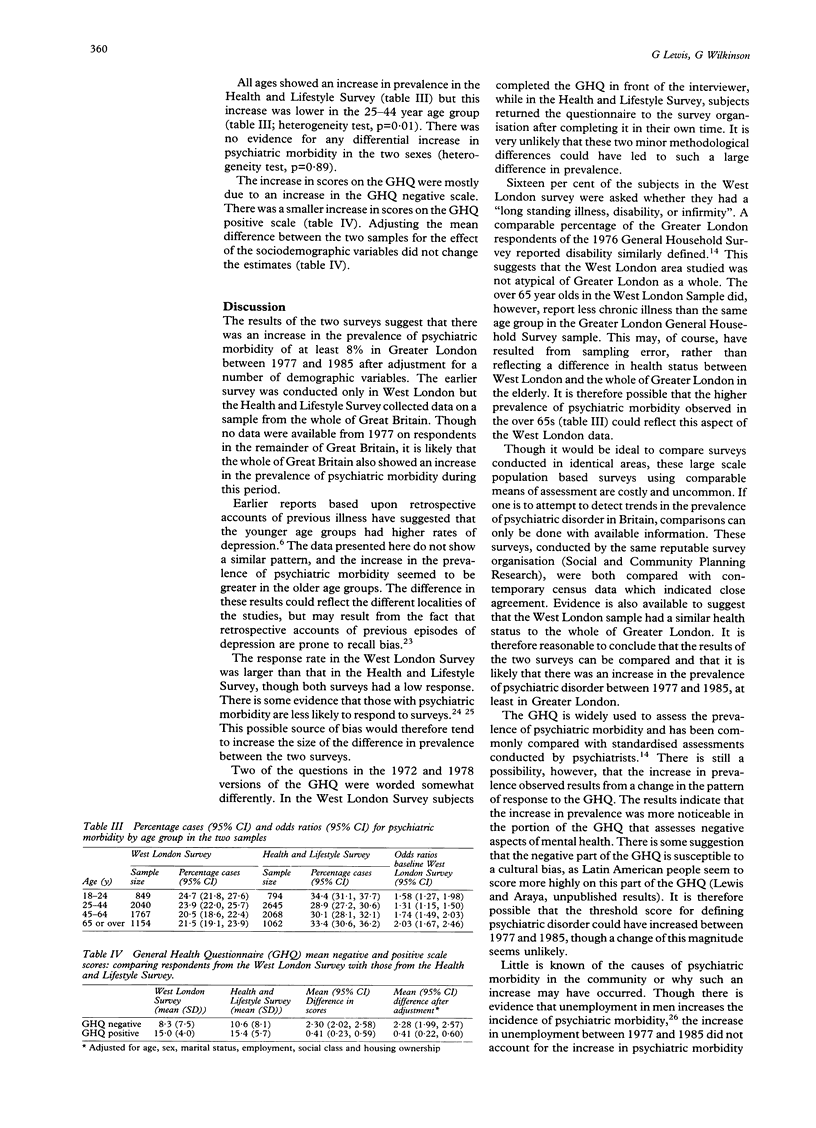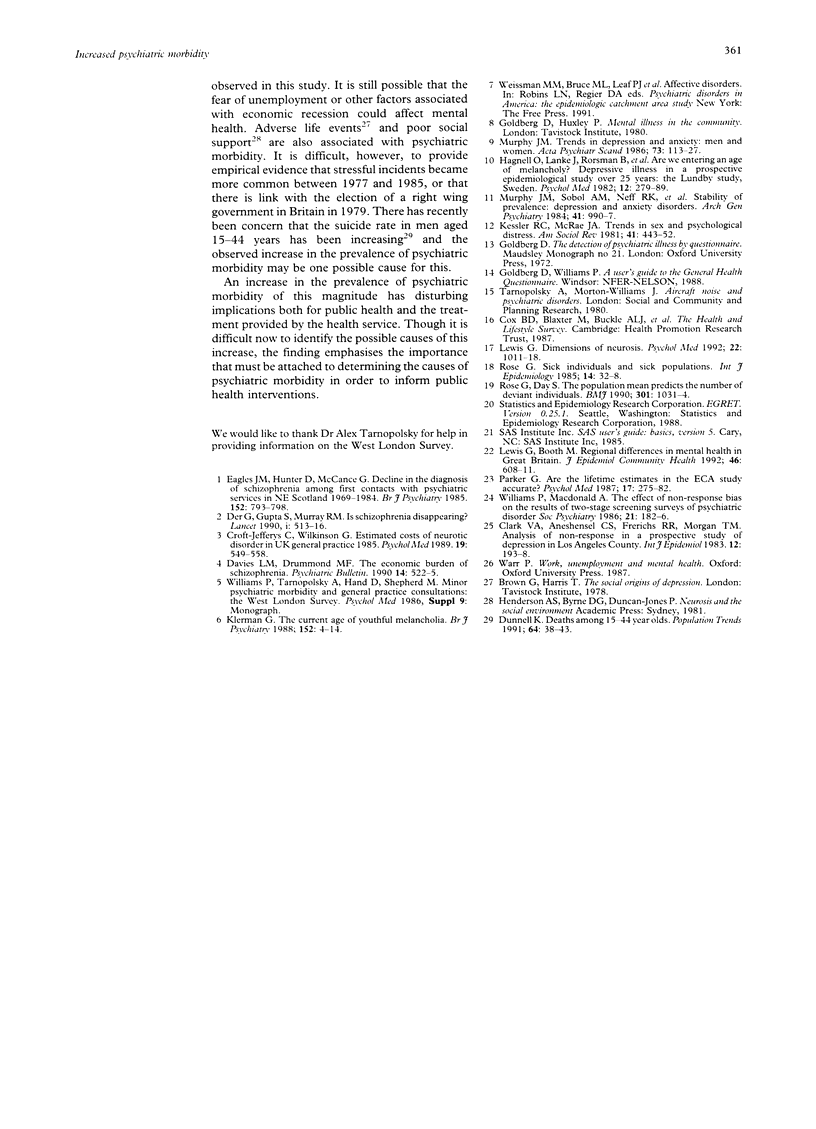Abstract
AIMS AND OBJECTIVE--To examine trends in the prevalence of psychiatric morbidity in Britain between 1977 and 1985. DESIGN--Secondary analysis of two cross sectional population based surveys. SETTING--The first survey was conducted in 1977 in West London and the second in 1984-85 throughout Great Britain. PARTICIPANTS--Members of the public randomly selected from the electoral register. MEASUREMENTS AND MAIN RESULTS--The main outcome was the prevalence of psychiatric morbidity assessed using the General Health Questionnaire, a self administered measure of neurotic symptoms. There was an increase of at least 8% (95% confidence interval 6.6, 9.8) in the prevalence of psychiatric morbidity between the times of the two surveys and this difference persisted after adjustment for any changes in the sex, age, employment status, marital status, social class, and housing tenancy between the two samples. When the analysis was restricted to the Greater London respondents of the Health and Lifestyle Survey a larger increase in psychiatric morbidity was seen. CONCLUSIONS--It is likely that there was an increase in the prevalence of psychiatric morbidity in Great Britain between these two surveys. Psychiatric morbidity is a public health problem of some importance and the causes of this increase require further study.
Full text
PDF



Selected References
These references are in PubMed. This may not be the complete list of references from this article.
- Clark V. A., Aneshensel C. S., Frerichs R. R., Morgan T. M. Analysis of non-response in a prospective study of depression in Los Angeles County. Int J Epidemiol. 1983 Jun;12(2):193–198. doi: 10.1093/ije/12.2.193. [DOI] [PubMed] [Google Scholar]
- Croft-Jeffreys C., Wilkinson G. Estimated costs of neurotic disorder in UK general practice 1985. Psychol Med. 1989 Aug;19(3):549–558. doi: 10.1017/s0033291700024132. [DOI] [PubMed] [Google Scholar]
- Eagles J. M., Hunter D., McCance C. Decline in the diagnosis of schizophrenia among first contacts with psychiatric services in north-east Scotland, 1969-1984. Br J Psychiatry. 1988 Jun;152:793–798. doi: 10.1192/bjp.152.6.793. [DOI] [PubMed] [Google Scholar]
- Hagnell O., Lanke J., Rorsman B., Ojesjö L. Are we entering an age of melancholy? Depressive illnesses in a prospective epidemiological study over 25 years: the Lundby Study, Sweden. Psychol Med. 1982 May;12(2):279–289. doi: 10.1017/s0033291700046614. [DOI] [PubMed] [Google Scholar]
- Kessler R. C., McRae J. A., Jr Trends in the relationship between sex and psychological distress: 1957-1976. Am Sociol Rev. 1981 Aug;46(4):443–452. [PubMed] [Google Scholar]
- Klerman G. L. The current age of youthful melancholia. Evidence for increase in depression among adolescents and young adults. Br J Psychiatry. 1988 Jan;152:4–14. doi: 10.1192/bjp.152.1.4. [DOI] [PubMed] [Google Scholar]
- Lewis G., Booth M. Regional differences in mental health in Great Britain. J Epidemiol Community Health. 1992 Dec;46(6):608–611. doi: 10.1136/jech.46.6.608. [DOI] [PMC free article] [PubMed] [Google Scholar]
- Lewis G. Dimensions of neurosis. Psychol Med. 1992 Nov;22(4):1011–1018. doi: 10.1017/s0033291700038575. [DOI] [PubMed] [Google Scholar]
- Murphy J. M., Sobol A. M., Neff R. K., Olivier D. C., Leighton A. H. Stability of prevalence. Depression and anxiety disorders. Arch Gen Psychiatry. 1984 Oct;41(10):990–997. doi: 10.1001/archpsyc.1984.01790210072009. [DOI] [PubMed] [Google Scholar]
- Murphy J. M. Trends in depression and anxiety: men and women. Acta Psychiatr Scand. 1986 Feb;73(2):113–127. doi: 10.1111/j.1600-0447.1986.tb10576.x. [DOI] [PubMed] [Google Scholar]
- Parker G. Are the lifetime prevalence estimates in the ECA study accurate? Psychol Med. 1987 May;17(2):275–282. doi: 10.1017/s0033291700024806. [DOI] [PubMed] [Google Scholar]
- Rose G., Day S. The population mean predicts the number of deviant individuals. BMJ. 1990 Nov 3;301(6759):1031–1034. doi: 10.1136/bmj.301.6759.1031. [DOI] [PMC free article] [PubMed] [Google Scholar]
- Williams P., Macdonald A. The effect of non-response bias on the results of two-stage screening surveys of psychiatric disorder. Soc Psychiatry. 1986;21(4):182–186. doi: 10.1007/BF00583998. [DOI] [PubMed] [Google Scholar]


